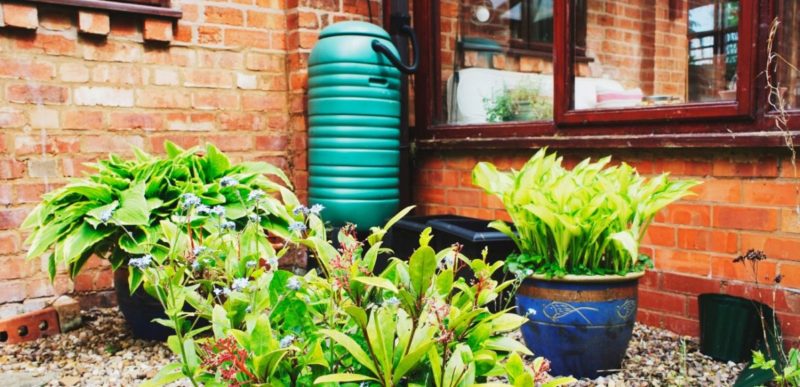Sustainability is trending, especially among young buyers, and an aesthetically pleasing rain barrel offers cost savings and curb appeal.
Outfitting a house with a rain barrel does more than collect and conserve rainwater: It saves money, too. Well-placed rain barrels help cut utility costs by collecting free water for gardening, lawn watering or even washing the car. And homeowners are taking note.
“There has absolutely been an increase in the popularity of rain barrels in the last decade,” says Francesca Corra, a Los Angeles–based landscape designer(link is external). She says that drought and mandatory water restrictions have highlighted the need for water conservation in California.
A rain barrel might sound like a breeding ground for mosquitoes or a potential eyesore, but it’s surprisingly easy to maintain and to camouflage these cost-cutting green home features. Here’s what to know if your clients want to add a rain barrel or spruce up an existing rain barrel before a home resale.
Benefits of Rain Barrels
Interest in rain barrels is rising, but as with many green concepts, the learning curve is still vast. Real estate professionals have a unique advantage in educating clients who don’t know much about this affordable water conservation solution.
After all, says Corra, homeowners were once concerned that solar panels could detract from a home’s appeal. Now? Fifty-two percent(link is external) of American homeowners have already installed, or given serious thought to installing, solar panels.
Rain Barrels Conserve Water
“One of the most important things everyone should be looking at right now is ways to retain any rainwater that falls on our properties and not send it out into the street. Is one rain barrel the solution to our drought problem? No, it is not. However, it does help,” Corra says.
“I have easily saved at least 500 gallons of water so far this spring and summer,” says Laura Peet, a homeowner and gardener with two 50-gallon rain barrels on either side of her Charlottesville, Virginia, home. Though Virginia is far less prone to droughts than are desert regions in California or Arizona, Peet says the clay soil tends to dry out quickly.
Rain Barrels Keep Landscaping Lush
“Whatever amount [the rain barrel] keeps from going out into the street is water saved for the plants in the garden,” says Corra. “Trees, especially, will always need more water, and they are in danger right now as more and more people are turning off their irrigation.”
Peet uses rain barrel water to keep her raised vegetable gardens lush. Tracey Zeeck, a communications director(link is external) and homeowner outside Oklahoma City, also enjoys using her rain barrel as an accessible, above-ground water source for gardening.
“I think it’s fun to capture it and use it when you want to—free water!” Zeeck says, adding that her husband thinks the plants thrive more when watered with harvested rain versus chlorinated city water.
Rain Barrels Attract Eco-Conscious Buyers
There’s no denying that more and more clients care about going green.
Fifty-one percent of real estate professionals say their buyer clients are interested in sustainability, according to National Association of REALTORS® data. Twelve percent of homeowners cite green home features as a reason for purchasing their current home, and 10% consider “landscaping for energy conservation” to be “very important.”
Rain barrels can play a small but important role in sustainability and water conservation. Saving rainwater “creates an awareness that we are doing something to help our environment,” says Corra.
How to Prevent Problems With Rain Barrels
Conserving water is excellent, but homeowners also need to keep their rain barrels from becoming problematic. Breeding insects can quickly destroy the tranquility of a yard.
Here’s what experienced rain barrel owners suggest for maintenance.
- Drain water regularly. A rain barrel isn’t meant to hold water indefinitely, says Corra. “Identify areas with the most need—i.e., trees, vegetable gardens, potted plants—and let the water out within a few days of the rain,” she adds.
- Install a mesh screen on top. If a rain barrel does not arrive fitted with a fine mesh at the entry point, installing a screen or fine netting is vital to keep debris and mosquitoes out of the water.
- Carefully consider position and elevation. “During a strong storm, the barrels will overflow, and you don’t want a steady stream of water to run against the house,” Peet says. “I have them nestled in gravel to keep any water flow away from the house.”
Conservation Chic: Can Rain Barrels Boost Curb Appeal?
There’s no reason to be concerned about rain barrels ruining the look of a home, according to Peet and Zeeck. And when they’re carefully selected to match the architectural style or disappear into the landscaping, these reservoirs of free water might actually boost curb appeal.
“Water barrels come in many shapes and sizes,” says Peet. “The ones I’ve purchased look like bourbon barrels, and I think they add a nice charm to my Craftsman-style home.”
With an increase in demand comes an increase in options, so homeowners are likely to find a rain barrel that fits the aesthetic of their home. It might also act as a conversation starter among like-minded potential buyers. After all, anyone who buys that home can now clearly signal a commitment to green living—and a lower water bill to prove it.
Source: nar.realtor













